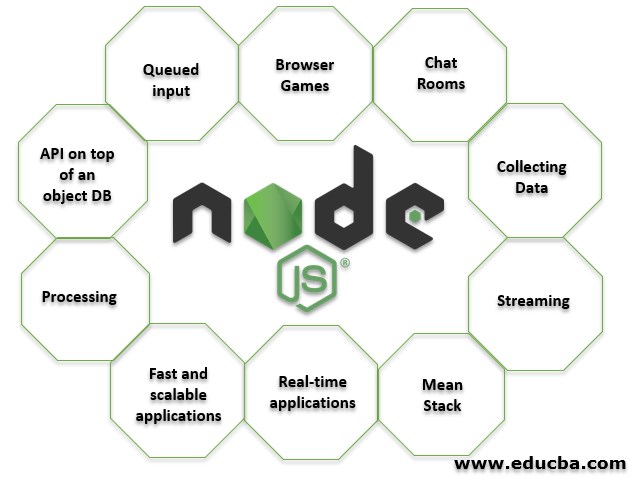Updated March 4, 2023
Introduction to Uses of Node.js
Node.js is a type of javascript that facilitates the users to run the program in run-time in an environment on external system other than the browser as a vessel. This advantageous Node.js javascript is widely used in chat rooms, real-time applications, web streaming options, for collection of data, data processing, browser games, in high-speed applications, the databases that are expected to be scalable/ expandable eventually, Application program interfaces applied on the databases, queueing applications like message queues, etc. This type of javascript is an extensive choice made by the majority of the software developers in recent years, as it helps in pushing the limitations on the development features.
What is that Node.js does?
- Node.js generates dynamic page content on the fly.
- Node.js creates, opens, reads, writes, deletes, and closes files on the server machine.
- Node.js collects form data as well.
- Node.js adds, deletes, modifies data in the databases.
Top 10 Uses of Node.js
The popular Uses of Node.js are as below:
1. Browser Games
Browser-based games are probably the most exciting application of real-time web. No longer users need to open up Flash, Java, or other programs such as Shockwave applet to play games. They do it right in their browsers. Node.js used in conjunction with Socket.io and HTML 5, rich and impressive real-time browser games can be designed. Other games such as multiplayer games as well can be created using the same technology.
2. Chat Rooms
These days it is true that most people use phone-based apps or social media platforms to chat with friends. uses of Node.js can create chat rooms very easily. Independent chat rooms probably not very popular on today’s Internet, but this is used a lot in online games which makes more fun when there is a chat component to them.
3. Collecting Data
Massive amounts of data can be collected and made more efficient with the uses of Node.js. large quantities of data into a database usually create a bottleneck, because database access is a blocked operation. Node.js, on the other hand, receive this data, then send it to the backend in a piecewise manner. This ensures that data gets stored without breaking any system.
4. Streaming
Video and audio media content files are uploaded to streaming video such as YouTube or Facebook and the same has to be processed to make it available for viewing or heard by users across the world. The processing of these files happens after they have been uploaded. Using applications of Node.js, these videos can be processed as they are being uploaded. This saves a lot of time and makes media widely accessible at fast speed. Other than video and audio, other data types such as input and output in real-time also require real-time processing to work on projects with colleagues spread halfway around the world.
5. Mean Stack
The MEAN Stack is all coded in JavaScript and hence it is worth looking at. Mean stack makes development simple and easy both for a developer standpoint and for the devices too. MEAN can be integrated with other modules too. Example: – Mongoose is used with Node.js that made integration with MongoDB much easier. Actually, N in Node.js stands for N in MEAN Stack.
6. Real-time Applications
Uses of Node.js is a great choice for those kinds of applications that process a high volume of short messages and require low latency. Such systems can be easily developed with Node.js. Uses of Node.js can also be a good choice for real-time collaborative drawing and editing-type apps. Example: – Trello, DropBox.
7. Fast and scalable Applications
Ruby on Rails probably is not sufficient in speed, if there are a ton of requests. uses of Node.js prove to be useful in such situations when faster and a more scalable program is needed. Node has the ability to process many requests, that too at low response times, and it shares things such as validation code between client machine and server. This makes applications of Node.js a great fit for modern web applications. carrying out lots of processing on the client’s side is possible with node.js. Node.js is a popular choice for single-page application sites and mobile apps, where rendering is done on the client’s side, and a JSON API is provided by a backend.
8. Processing
Node.js also very useful, when high volumes of IO-bound requests are to be processed. If a lot of CPU processing requests are required to serve the request, it will not be efficient. if it’s primarily and considers only shuffling data around, then node.js will be quite efficient. A single instance serves a lot more requests than too with the same hardware. Node.js compared to the usual big and thick applications is better such as rails.
9. API on top of an object DB
Although Node.js really shines with real-time applications, it’s quite a natural fit for exposing the data from object DBs (e.g. MongoDB). JSON stored data allow Node.js to function even when there is no impedance mismatch and there is data conversion
10. Queued Input
If a huge amount of simultaneous data is received, a database does become a bottleneck as explained above. But, applications of Node.js can handle the database concurrent connections. The system maintains its responsiveness even under a heavy load and that is particularly useful
Conclusion
JavaScript is rising in popularity and has brought a lot of changes in the internet and browser-based coding. Web development approach today is dramatically different, and it is due to JavaScript and Node.js. The things that we can be done on the web with JavaScript running on the server, has huge scope and possibilities. Hence, learning and knowing node.js is a great skill. Students should learn it and practice hands-on coding. Node.js based questions are asked in web development interviews as well.
Recommended Articles:
This has been a guide to Uses of Node.js in the real world. Here we have discussed Introduction to Node.js, along with the top 10 popular uses of node.js in detail. You may also look at the following article to learn more –





